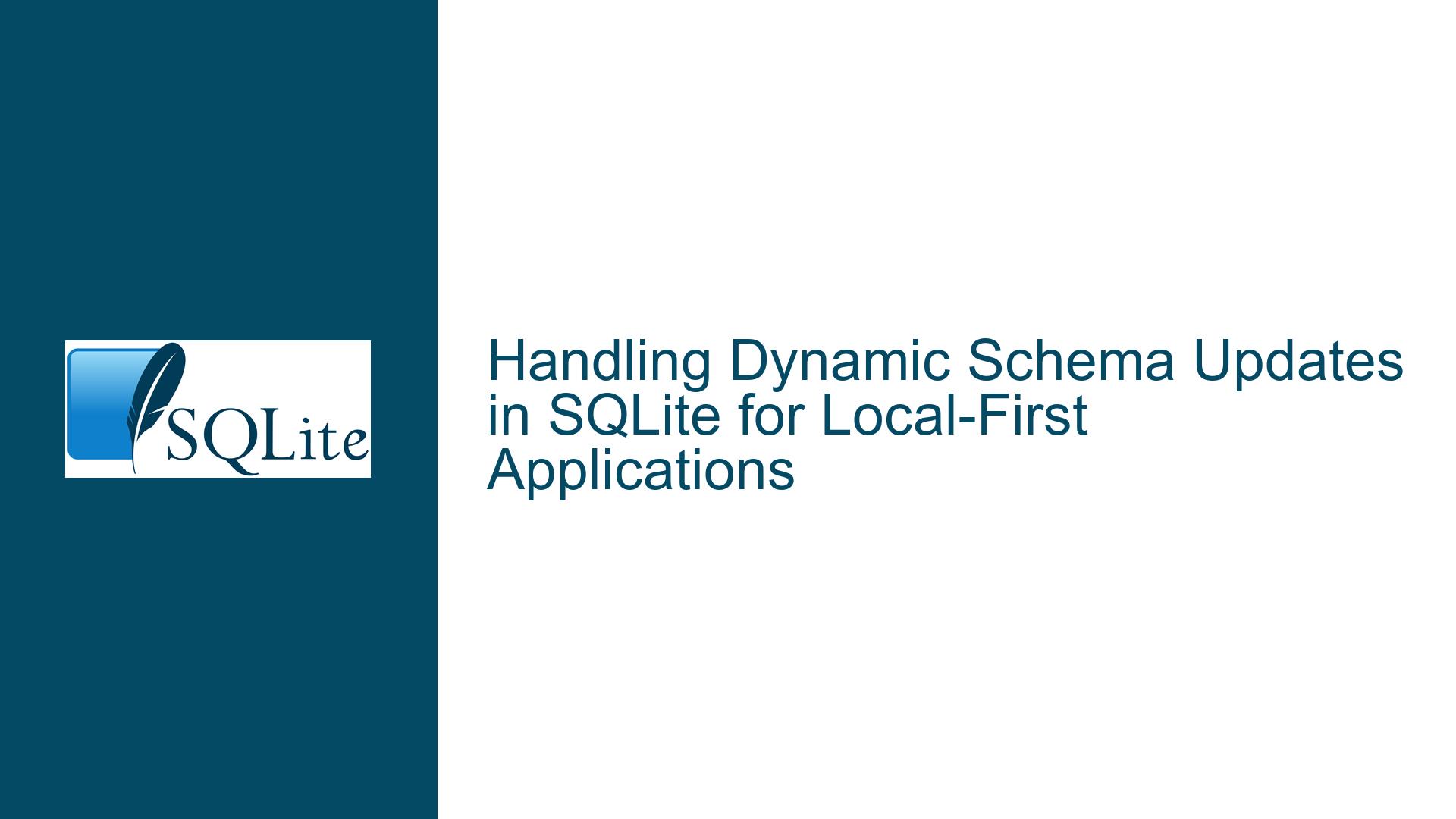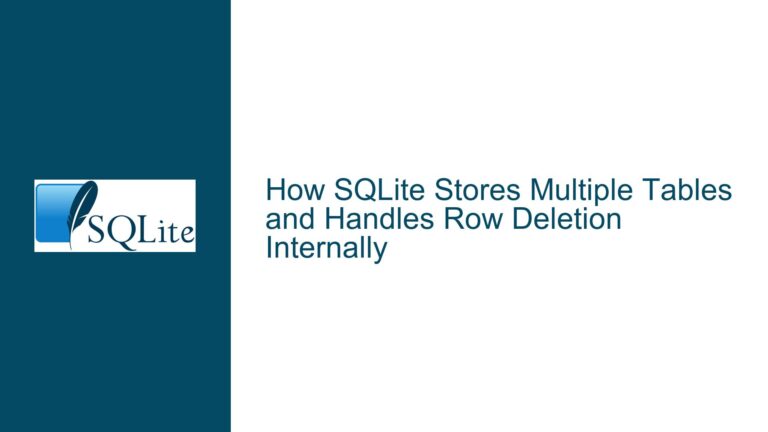Handling Dynamic Schema Updates in SQLite for Local-First Applications
Dynamic Schema Evolution in SQLite: A Local-First Use Case
SQLite is a lightweight, serverless relational database management system (RDBMS) that is widely used for its simplicity, portability, and efficiency. However, one of the challenges that developers face when using SQLite in local-first applications is the need to dynamically evolve the database schema without requiring explicit migrations. Local-first applications, which prioritize offline functionality and seamless synchronization, often require a schema that can adapt to changes in the application’s data model over time. This post delves into the core issue of dynamically updating the schema in SQLite, exploring the underlying challenges, potential causes, and detailed solutions.
Issue Overview: Schema Evolution in Local-First Applications
Local-first applications are designed to work offline and synchronize data across multiple devices without requiring a central server. These applications often use Conflict-free Replicated Data Types (CRDTs) to ensure that data changes can be merged without conflicts, regardless of the order in which they are applied. In such a context, the database schema must be flexible enough to accommodate changes introduced by different versions of the application, which may be running concurrently on different devices.
The primary challenge in this scenario is that the schema cannot be fixed or predefined. Instead, it must evolve dynamically as the application evolves. This means that the database must be able to handle queries that reference tables or columns that do not yet exist, and it must be able to create those tables or columns on the fly. This approach is in stark contrast to traditional database systems, where the schema is typically defined upfront and changes are managed through explicit migrations.
In SQLite, the schema is an integral part of the database. When a query references a table or column that does not exist, SQLite returns an error. In a local-first application, the application must be able to catch these errors, infer the missing schema elements, and create them before retrying the query. This process must be seamless and efficient, as frequent schema changes could otherwise lead to performance degradation or data inconsistency.
The core issue, therefore, is how to implement a mechanism in SQLite that allows for dynamic schema updates while maintaining data integrity and performance. This requires a deep understanding of SQLite’s error handling, schema management, and transaction control mechanisms.
Possible Causes: Why Dynamic Schema Updates Are Challenging
Dynamic schema updates in SQLite are challenging for several reasons, each of which must be carefully considered when designing a solution for local-first applications.
1. Schema Rigidity in SQLite: SQLite is a relational database, and like all RDBMSs, it enforces a strict schema. Tables and columns must be defined before they can be used in queries. When a query references a non-existent table or column, SQLite returns an error. This rigidity is at odds with the need for dynamic schema evolution in local-first applications, where the schema must adapt to changes introduced by different versions of the application.
2. Error Handling and Recovery: In a dynamic schema evolution scenario, the application must be able to catch errors related to missing schema elements and recover from them by creating the necessary tables or columns. This requires robust error handling and the ability to infer the missing schema elements from the failed query. SQLite provides error codes that indicate the nature of the error (e.g., "no such table" or "no such column"), but the application must be able to parse these errors and take appropriate action.
3. Transaction Management: Dynamic schema updates can complicate transaction management. In SQLite, schema changes (such as creating or altering tables) implicitly commit any active transaction. This means that if a schema change is made in response to a query error, the application must ensure that any pending changes are properly handled before the schema change is applied. Failure to do so could result in data inconsistency or loss.
4. Performance Considerations: Frequent schema changes can impact the performance of the database. Each schema change requires SQLite to update its internal data structures, which can be costly in terms of both time and resources. In a local-first application, where schema changes may occur frequently, this could lead to performance degradation unless carefully managed.
5. Data Integrity and Constraints: SQLite supports various data integrity constraints, such as foreign keys, unique constraints, and check constraints. These constraints are typically defined as part of the schema and are enforced by the database. In a dynamic schema evolution scenario, the application must ensure that any new tables or columns adhere to the necessary constraints. This can be particularly challenging when the schema is evolving in response to queries from different versions of the application, each of which may have different expectations about the data model.
6. Schema Inference: In a dynamic schema evolution scenario, the application must be able to infer the necessary schema changes from the failed query. This requires parsing the query and determining which tables or columns are missing. While SQLite provides some tools for querying the schema (e.g., PRAGMA table_info), the application must still implement logic to infer the necessary changes and apply them.
Troubleshooting Steps, Solutions & Fixes: Implementing Dynamic Schema Updates in SQLite
Implementing dynamic schema updates in SQLite requires a combination of error handling, schema inference, and transaction management. The following steps outline a detailed approach to achieving this in a local-first application.
1. Error Handling and Schema Inference: The first step in implementing dynamic schema updates is to catch errors related to missing schema elements and infer the necessary changes. When a query fails with an error indicating that a table or column does not exist, the application must parse the error and determine which schema elements are missing. This can be done by examining the error message and the failed query.
For example, if a query fails with the error "no such table: my_table", the application can infer that the table my_table needs to be created. Similarly, if the error is "no such column: my_column", the application can infer that the column my_column needs to be added to the relevant table.
Once the missing schema elements have been inferred, the application can generate the necessary SQL statements to create the table or add the column. These statements can then be executed before retrying the original query.
2. Transaction Management: Dynamic schema updates can complicate transaction management, as schema changes implicitly commit any active transaction. To handle this, the application should ensure that any pending changes are properly committed or rolled back before applying schema changes.
One approach is to use nested transactions or savepoints. Before executing a query that may require a schema update, the application can create a savepoint. If the query fails and a schema update is required, the application can roll back to the savepoint, apply the schema changes, and then retry the query. This ensures that any pending changes are properly handled before the schema is updated.
3. Schema Versioning: To manage schema changes over time, the application can use schema versioning. This involves storing a version number in the database (e.g., in a special table or using the user_version pragma) and updating it whenever the schema is changed. When the application starts, it can check the schema version and apply any necessary updates to bring the schema up to date.
Schema versioning allows the application to manage schema changes in a controlled manner, ensuring that the schema is always consistent with the application’s data model. It also provides a mechanism for handling backward and forward compatibility, as different versions of the application may have different schema requirements.
4. Performance Optimization: Frequent schema changes can impact the performance of the database, so it is important to optimize the schema update process. One approach is to batch schema changes, applying multiple changes in a single transaction. This reduces the overhead associated with each schema change and can improve overall performance.
Another approach is to cache schema information in the application. Instead of querying the database schema each time a query is executed, the application can cache the schema information and update it only when necessary. This reduces the number of schema queries and can improve performance.
5. Data Integrity and Constraints: When dynamically updating the schema, the application must ensure that any new tables or columns adhere to the necessary data integrity constraints. This can be challenging, as the application may not have complete information about the constraints when the schema is updated.
One approach is to define a minimal set of constraints that are always enforced, and then allow the application to add additional constraints as needed. For example, the application could enforce basic constraints such as primary keys and not-null constraints, and then allow additional constraints (e.g., foreign keys, unique constraints) to be added later.
6. Testing and Validation: Dynamic schema updates introduce additional complexity, so it is important to thoroughly test and validate the schema update process. This includes testing for edge cases, such as concurrent schema updates, and ensuring that the application can handle schema changes gracefully.
One approach is to use automated tests that simulate different schema evolution scenarios. These tests can verify that the application correctly handles schema changes and that the database remains consistent after each change.
7. Alternative Approaches: While dynamic schema updates can be implemented in SQLite, it is worth considering alternative approaches that may be better suited to the requirements of local-first applications. For example, some applications may benefit from using a schema-less database, such as a key-value store, which allows for more flexible data modeling.
Another approach is to use a hybrid model, where the application uses SQLite for structured data and a schema-less database for unstructured data. This allows the application to leverage the strengths of both approaches, using SQLite for complex queries and the schema-less database for flexible data storage.
In conclusion, implementing dynamic schema updates in SQLite for local-first applications is a complex but achievable task. By carefully handling errors, managing transactions, and optimizing performance, developers can create a flexible and robust schema evolution mechanism that meets the needs of their applications. However, it is important to thoroughly test and validate the schema update process, and to consider alternative approaches where appropriate.






